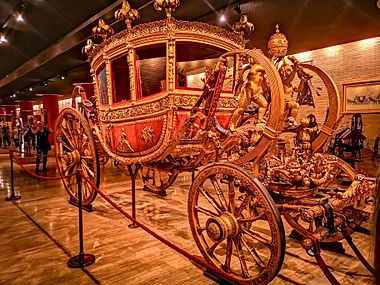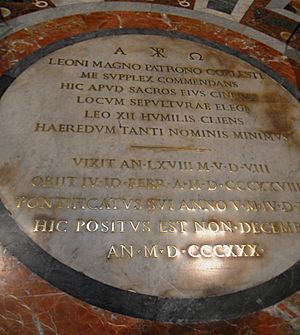Pope Leo XII facts for kids
Quick facts for kids Pope Leo XII |
|
|---|---|
| Bishop of Rome | |
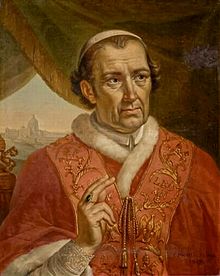
Portrait by Charles Picqué, 1828
|
|
| Church | Catholic Church |
| Papacy began | 28 September 1823 |
| Papacy ended | 10 February 1829 |
| Predecessor | Pius VII |
| Successor | Pius VIII |
| Orders | |
| Ordination | 4 June 1783 |
| Consecration | 24 February 1794 by Henry Benedict Stuart, Duke of York |
| Created Cardinal | 8 March 1816 |
| Personal details | |
| Birth name | Annibale Francesco Clemente Melchiorre Girolamo Nicola della Genga |
| Born | 2 August 1760 Genga, Papal States |
| Died | 10 February 1829 (aged 68) Rome, Papal States |
| Previous post |
|
| Signature | |
| Coat of arms |  |
| Other Popes named Leo | |
Pope Leo XII (born Annibale Francesco Clemente Melchiorre Girolamo Nicola della Genga; 2 August 1760 – 10 February 1829) was the leader of the Catholic Church. He also ruled the Papal States from 1823 until his death in 1829.
He was known for being very traditional in his beliefs and rules. Even though he was often unwell, he worked hard during his time as Pope. He tried to improve the finances of the Papal States, but they remained quite poor.
Contents
Biography
Early Life and Family History
Annibale della Genga was born in 1760 at Castello della Genga. This was a castle in the area of Fabriano, part of the Papal States. His family was an old noble family from Genga.
He was the sixth of ten children. His parents were Count Ilario della Genga and Maria Luisa Periberti di Fabriano. His nephew, Gabriele della Genga Sermattei, later became a cardinal.
Education and Becoming a Priest
Della Genga studied to become a priest. He attended Collegio Campana in Osimo from 1773 to 1778. Then he studied at Collegio Piceno in Rome until 1783. After that, he joined the Pontifical Academy of Ecclesiastical Nobles.
He became a deacon in 1782 and a priest on 14 June 1783. Cardinal Marcantonio Colonna ordained him.
Serving the Pope as a Nuncio
Della Genga worked as a nuncio, which is like an ambassador for the Pope. He served in Switzerland. In 1790, he gave a well-received speech about the late Emperor Joseph II.
In 1794, Pope Pius VI made him an archbishop. He was sent to Lucerne as the Pope's representative. Later that year, he moved to Cologne. However, because of a war, he had to live in Augsburg. During his time in Germany, he handled important missions. He met with leaders in Dresden, Vienna, Munich, and Württemberg. He also met with Napoleon I of France.
After Napoleon took over the Papal States in 1798, della Genga lived at Monticelli Abbey. He enjoyed music and hunting birds, even after becoming Pope.
Becoming a Cardinal
In 1814, della Genga was chosen for an important task. He delivered Pope Pius VII's congratulations to Louis XVIII of France. This was when Louis XVIII became king again.
On 8 March 1816, he became a cardinal. He was given the title of Cardinal-Priest of Santa Maria in Trastevere. He later became the Archpriest of the Basilica di Santa Maria Maggiore. He also became the bishop of Sinigaglia, but he resigned in 1818 due to health issues. He never actually visited his diocese.
On 9 May 1820, Pope Pius VII gave him another important role. He became the Vicar-General of His Holiness for the Diocese of Rome. This meant he helped manage the Church in Rome.
Becoming Pope
| Papal styles of Pope Leo XII |
|
|---|---|
 |
|
| Reference style | His Holiness |
| Spoken style | Your Holiness |
| Religious style | Holy Father |
| Posthumous style | None |
The Papal Election
Pope Pius VII passed away in 1823. The cardinals then met to choose a new Pope in a meeting called a conclave. Della Genga was chosen on 28 September 1823. He took the name Leo XII.
Many thought he was very ill and close to death. He even told the cardinals they would be electing "a dead man." But he surprised everyone by getting better after his election.
Leo XII was 63 years old when he became Pope. He was tall and thin and often looked serious. He had a strong dedication to his work.
A Special Story: Saint Vincenzo Strambi
There is a touching story about Vincenzo Strambi, who was an advisor to Pope Leo XII. In 1825, the Pope became very ill. Strambi offered his own life to God so that the Pope could recover. Amazingly, Pope Leo XII got better, but Strambi passed away from a stroke within a week.
Cardinal Fabrizio Ruffo crowned Leo XII as Pope on 5 October 1823.
Pope Leo XII's Time as Leader
Dealing with Other Countries
Pope Leo XII's first Secretary of State, Ercole Consalvi, was dismissed. A Secretary of State is like a chief minister. Leo XII's foreign policy focused on making agreements with other countries. These agreements, called concordats, were very good for the Papacy.
He was very careful with money himself. He lowered taxes and made legal processes cheaper. He also found money for some public projects. However, the Church's finances were still a bit messy when he died. Even a big celebration in 1825, called a jubilee, did not fix the money problems.
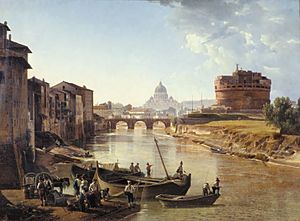
Rules for His Own People
Leo XII had very traditional ideas for how society should be run. He wanted to bring things back to older ways. He did not approve of Bible societies. He also changed the education system. He put it completely under the control of priests. He required all high school teaching to be in Latin. All court cases also had to be in Latin and handled by Church officials. All charities in the Papal States were directly supervised by the Church.
He made some rules that were not popular. For example, he made it harder for Jewish people to own property. He also required all Roman residents to listen to Catholic teachings. These rules caused many Jewish people to move away from Rome.
His strict way of ruling led to some unrest. There were rebellions and secret groups. He strongly pursued groups like the Carbonari and Freemasons. These groups had liberal ideas.
Many people found his rules about daily life too strict. He even said that a dressmaker who sold certain types of dresses would be excommunicated. He brought back old rules from the Middle Ages. These rules included separating groups of people and making them wear special marks.
Important Activities
Recognizing Holy People
Pope Leo XII officially recognized 15 individuals as "Blessed" during his time. This process is called beatification. Some of these included Angelina di Marsciano and Bernardo Scammacca in 1825. He also recognized Imelda Lambertini in 1826.
He also declared Peter Damian a "Doctor of the Church" in 1828. This is a special title given to saints who have made important contributions to theology.
Supporting Religious Groups
The Pope officially recognized the Missionary Oblates of Mary Immaculate on 17 February 1826. This gave the religious group official approval.
The Jubilee of 1825
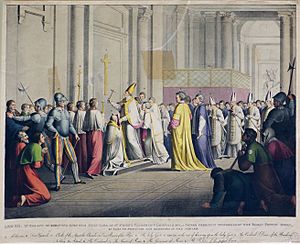
Leo XII celebrated a special event called a jubilee in 1825. Over half a million pilgrims came to Rome for the celebrations. To announce the jubilee, Leo XII issued a special letter called an encyclical. It was called Quod hoc ineunte and was released on 24 May 1825.
Creating New Cardinals
He held 8 "consistories" where he appointed 25 new cardinals. A consistory is a formal meeting of the College of Cardinals. One of these new cardinals was Bartolomeo Alberto Cappellari. He later became Pope Gregory XVI.
Death and What He Left Behind

On 5 February 1829, Pope Leo XII became suddenly ill after a meeting. He seemed to know that he was going to die soon. He received his last rites on 8 February. He lost consciousness on 9 February and passed away the next morning.
He was buried in St. Peter's Basilica on 15 February 1829. His remains were later moved to be buried near the altar of Pope Leo I in 1830.
Pope Leo XII was seen as a noble person who liked order and efficiency. However, he did not always understand the changes happening in the world around him. His rule was not very popular in Rome and the Papal States. His policies made it harder for future Popes to solve the new problems they faced.
Images for kids
See also
 In Spanish: León XII para niños
In Spanish: León XII para niños
- Cardinals created by Leo XII
- List of popes


